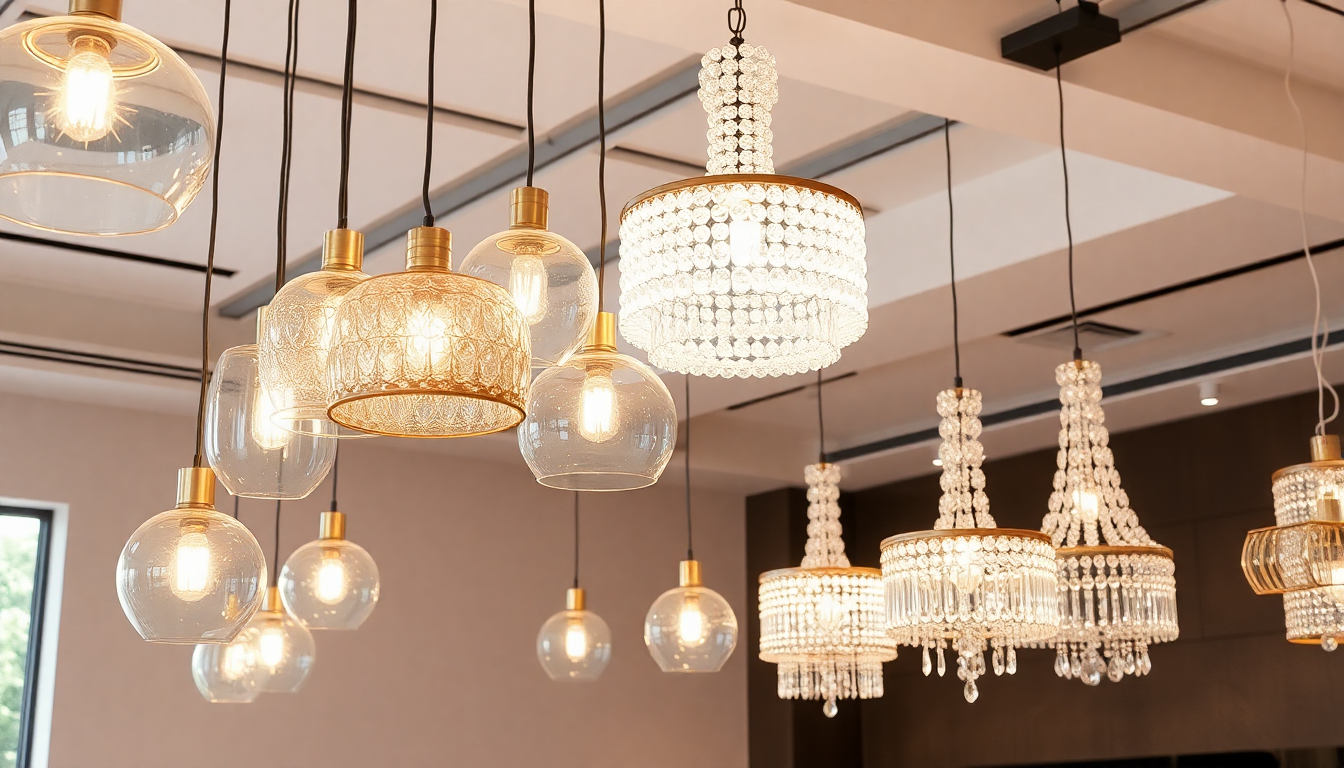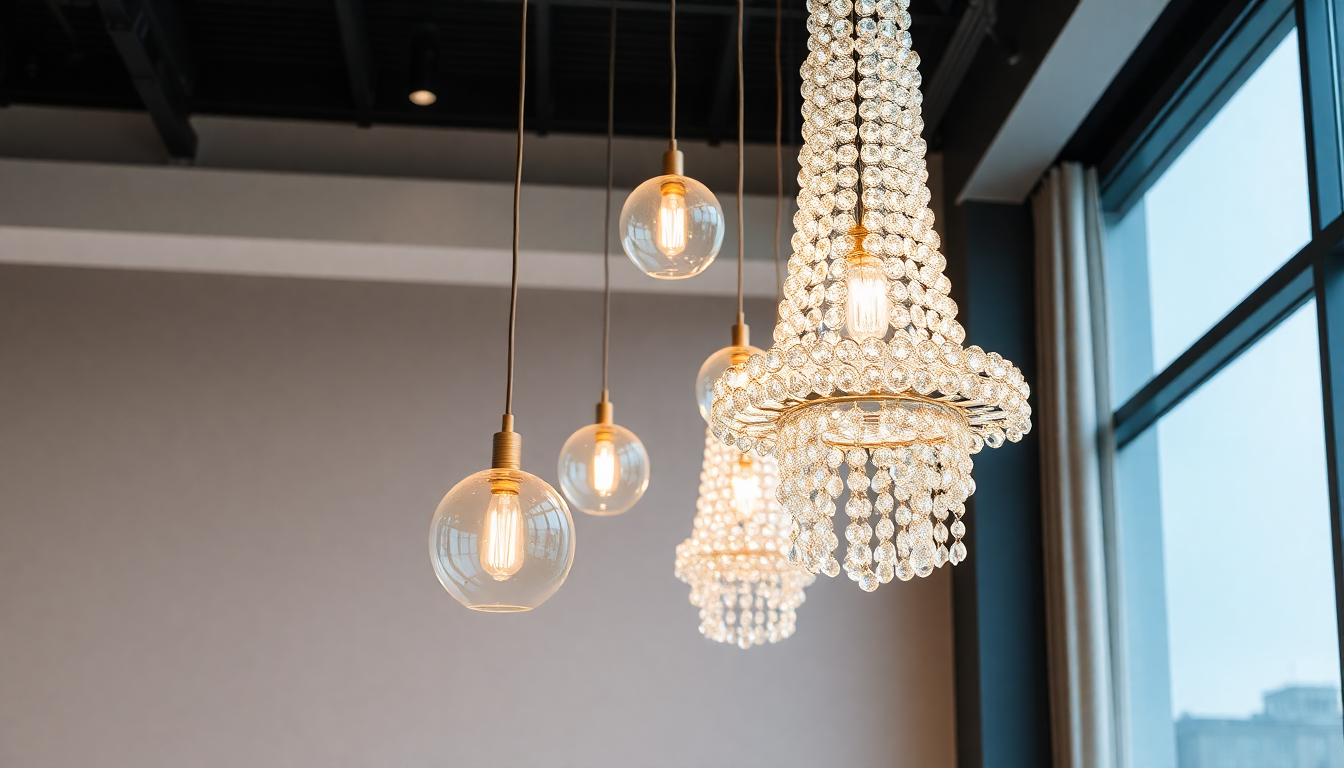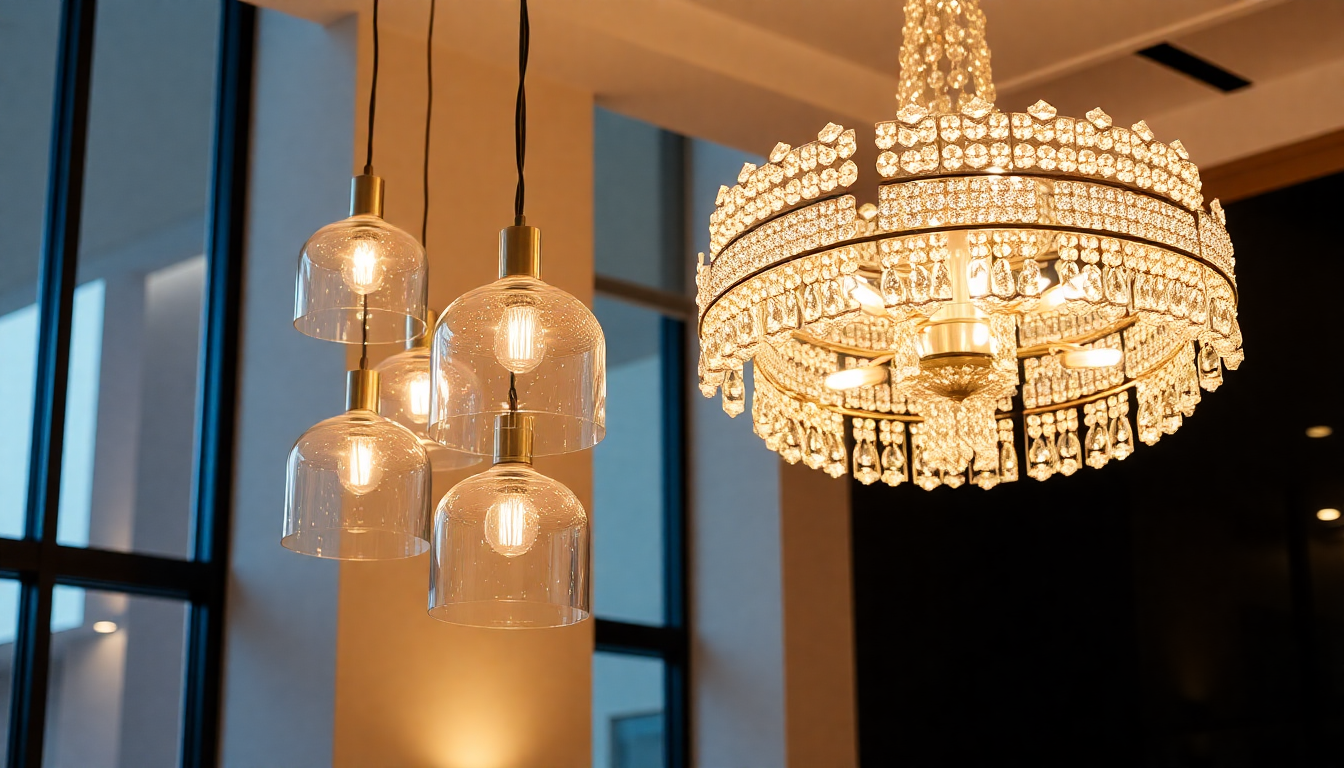Introduction: The Lasting Appeal of Glass Pendant Lighting
Glass pendant lighting transforms a room with glare-free glow, sculptural form, color and reflective sparkle. From a single milk glass pendant light floating over a bedside table to a cluster of blown glass pendant lights cascading above a kitchen island, glass fixtures offer versatility for modern, traditional and eclectic interiors. When paired with a crystal chandelier, glass pendants can create a layered, luxurious lighting scheme that looks curated and professional.
Why This Guide Matters (SEO & Practical Goals)
This comprehensive guide covers everything you need to choose bulbs, protect finishes, care for glass, style milk, stained and blown glass with crystal chandeliers, and shop smart. It also targets search queries around glass pendant lights, glass pendant lighting, milk glass pendant light, stained glass pendant light and blown glass pendant lights to help this post rank well for shoppers and design-minded readers.
Understanding Light: Bulb Types and Why They Matter for Glass Pendants
Choosing the right bulb is the first step in optimizing both the look and the function of your glass pendant lighting. Bulb choices influence color, mood, heat, energy use, and even how finishes age.
-
LED (Light Emitting Diode)
- Pros: Energy-efficient, low heat, long life (15,000–50,000+ hours), available in many color temperatures and dimmable models.
- Best for: Most glass pendant lights including milk glass, stained glass pendant lights and blown glass pendant lights. High-CRI LEDs (90+) are recommended for accurate color rendering.
-
Halogen
- Pros: Good color rendering, bright white light.
- Cons: Runs hotter, less efficient than LED, shorter life. Not ideal for enclosed glass shades or delicate finishes.
-
Incandescent
- Pros: Warm light and pleasing dimming characteristics.
- Cons: Inefficient, short-lived, and producing heat that can stress glass seals or patinas—LED alternatives are usually better.
-
CFL (Compact Fluorescent)
- Pros: Efficient compared to incandescent.
- Cons: Bulky shapes may not fit small pendant shades; slower warm-up and poor dimming compatibility vs. LED.
- Specialty bulbs (filament-style LED, vintage Edison, smart bulbs): Choose filament-style LEDs for vintage looks without excess heat. Smart bulbs add color temperature control and scene setting via apps or voice assistants.
Color Temperature, CRI and Lumens—How to Specify for Glass Pendants
-
Color Temperature (Kelvin):
- 2700K–3000K: Warm, golden—great for dining rooms, living rooms, and bedrooms.
- 3000K–3500K: Neutral—great for kitchens and general living areas.
- 3500K–5000K: Cool—best for task-heavy areas like garages or home offices.
- CRI (Color Rendering Index): Aim for CRI 90+ if you want rich, accurate colors—especially important with stained glass pendant light fixtures where color fidelity is a central feature.
- Lumens vs. Watts: Use lumens to determine brightness. A typical pendant over a kitchen island should deliver 400–800 lumens per fixture depending on task levels. Replace the old watt-based thinking with lumen targets and confirm the fixture’s max-wattage spec when using non-LED bulbs.
Dimming & Compatibility
- Use dimmable LED bulbs and match them with an LED-compatible dimmer to avoid flicker and buzzing. Check bulb packaging for dimmer compatibility lists.
- For multiple pendants on one circuit, ensure the dimmer’s load rating matches the combined wattage of all bulbs.
Heat Considerations and How Bulbs Affect Finishes
Excess heat can discolor metal hardware, weaken adhesives, and accelerate oxidation of finishes. Because LEDs run much cooler than incandescents or halogens, they are the safest choice for glass pendant lighting—especially for delicate milk glass pendant light finishes or older, hand-finished crystal chandeliers.
Deep Dive: Glass Types, Visual Qualities and Best Uses
- Clear glass pendant lights: Crisp, modern, and versatile. Ideal for showcasing filament bulbs and for minimalist interiors. Clear glass pairs well with chrome or nickel hardware and can be used where visual light projection is desired.
- Milk glass pendant light: Opaline and diffused, milk glass offers soft, shadow-free illumination. Use in bedrooms, bathrooms and over dining tables to create a warm ambient glow. Milk glass looks excellent alongside warm-finish crystal chandeliers—its matte diffusion tones down crystal sparkle for a cohesive look.
- Stained glass pendant light: Rich color, pattern, and artisanal detail. Best used as accents—pendants over small dining nooks, bedside tables or a cozy reading corner. Because stained glass often has saturated colors, pair it with neutral crystal chandeliers or mirrored surfaces to avoid color overload.
- Blown glass pendant lights: Hand-blown pendants are sculptural and unique—no two are exactly the same. Use them as statement pieces or in clusters at varying heights. Blown glass can have color gradations and textures that look stunning against crystal chandeliers that add sparkle without competing with organic shapes.
- Frosted & etched glass: Great for soft, even illumination—ideal where glare control or privacy is needed, such as above bathroom vanities or in hallways.
Step-by-Step Cleaning and Care: Save Finishes and Preserve Sparkle
Regular care extends the life of glass pendants and crystal chandeliers. Use the following step-by-step cleaning procedures tailored by glass type.
-
General safety first:
- Turn off power at the wall switch. For extra safety, switch off the circuit breaker if you’ll remove fixtures or bulbs.
- Allow bulbs to cool before handling.
- Use a stable ladder and have a helper for heavy fixtures.
-
Clear & blown glass pendant lights:
- Gently remove the glass shade if possible.
- Wash in warm water with a small amount of mild dish soap. Avoid abrasive pads.
- Rinse thoroughly and dry with a lint-free microfiber cloth to prevent water spots.
- Polish with a dry microfiber cloth to remove any remaining streaks.
-
Milk glass:
- Do not use ammonia or harsh spray cleaners; they can compromise certain finishes.
- Wash with warm water and mild soap, rinse, and dry immediately.
- Use a soft cotton cloth for drying to prevent scratches.
-
Stained glass pendant light:
- Wipe gently with a damp microfiber cloth. For grime in leaded joints, use a soft-bristled brush.
- Avoid vinegar or ammonia-based cleaners on soldered or leaded seams; these chemicals can corrode joints.
- For resistant residue, consult a stained glass professional.
-
Crystal chandelier pairing:
- Dust regularly with a feather duster or microfiber cloth to prevent buildup.
- For deep cleaning, remove crystals if practical and clean with warm water and a mild soap solution; dry individually before rehanging. Use gloves to prevent fingerprints.
- If cleaning in situ, place a soft sheet beneath the chandelier to catch any dropped pieces and use a spray-on crystal cleaner designed for chandeliers, following instructions carefully.
Protecting Metal Finishes and Patinas
- Avoid ammonia-based cleaners on brass, brass-plated, and antique finishes.
- Use manufacturer-approved polishes for polished brass or antique bronze. For brushed and painted finishes, a damp cloth followed by a dry one is often safest.
- Apply a thin microcrystalline wax sparingly to true brass to slow tarnishing; test in an inconspicuous area first.
- When hanging or adjusting fixtures, wear cotton gloves to prevent oils from your hands transferring to metal or glass.
Installation: Safe Mounting, Wiring Considerations and Professional Help
- Always follow the fixture’s installation instructions and local electrical codes.
- For heavy fixtures or crystal chandeliers, use an outlet box rated for the fixture’s weight and, if necessary, a cross brace or support bar.
- Consider hiring a licensed electrician for complex junctions, multi-gang dimmer installs, or when adding pendant clusters on a single canopy.
- When wiring multiple pendants to one canopy, ensure wire gauge and circuit load can handle the combined bulbs.
Placement, Proportion and Spacing Rules
Good placement is as important as the fixture itself. Here are practical rules designers use.
- Kitchen Island: Hang pendants 28–34 inches above the counter (lower for seated bar counter islands), and space pendants 24–30 inches center-to-center—use more pendants for longer islands.
- Dining Table: Hang 30–36 inches above the tabletop for 8–9 foot ceilings; add 3 inches per additional foot of ceiling height. Use a chandelier or a row of pendants for long tables.
- Foyer/Entry: Scale matters—a tall entry may require a large crystal chandelier as a central anchor with small pendant accents in adjacent spaces.
- Clusters & Groupings: Odd-numbered clusters (3, 5, 7) feel visually balanced. Stagger heights for a dynamic look, especially with blown glass pendant lights.
Styling Scenarios: Room-by-Room Examples
- Kitchens & Dining Areas: Use glass pendant lighting over islands and dining tables. Clear glass pendants provide task clarity; milk glass pendant light options create a softer mood for dining. For contrast, pair a warm brass crystal chandelier over the dining table with blown glass pendants over the island to combine glamour and artisanal form.
- Living Rooms: Consider a central crystal chandelier for ambient light and use milk or frosted glass pendant lights as reading or accent fixtures near sofas and side tables.
- Bedrooms: Swap bedside lamps for milk glass pendant lights to save surface space and create an intimate two-light scheme when paired with a small crystal fixture or mirror for sparkle.
- Bathrooms: Choose damp-rated pendants (check UL/ETL ratings) and prefer milk or frosted glass to diffuse harsh vanity glare. Avoid fixtures not rated for damp or wet locations.
- Entry & Stairwells: Layer a single statement blown glass pendant with smaller crystal accents or sconces to guide the eye upward and create drama.
Mixing and Matching: How to Combine Glass Pendants with Crystal Chandeliers
Mixing materials can elevate a scheme, but the balance is key.
- Match scale first: A large crystal chandelier requires pendants that won’t get visually lost—choose larger blown glass or multiple pendants in a row.
- Harmonize finishes: Either match metal finishes (e.g., brushed brass pendants with a brass chandelier) or choose complimentary tones (warm brass with aged nickel for contrast).
- Use glass pendants to tune sparkle: Where a crystal chandelier may create glare or strong reflections, milky or frosted glass pendants can soften the overall lighting while maintaining coherence.
- Color coordination: If you have stained glass pendant light fixtures with strong color, keep the chandelier neutral or clear to avoid competing focal points.
Statement Pendants: Making Lighting the Focal Point
Statement glass pendant lights are often sculptural blown-glass or oversized milk glass forms. Use these design tips:
- Center a single oversized pendant over a round table or an entry console.
- Allow height and negative space — don’t crowd the pendant with too many other large elements.
- Use a neutral backdrop or monochrome palette to let the pendant’s color and texture shine.
Case Studies & Product Inspiration
Below are curated product examples to illustrate different looks. Replace links with your actual product pages if you have them. Each example is paired with an image to help shoppers visualize the look.
-
Classic Clear Glass Pendant
https://yourstore.com/products/clear-glass-pendant
Use: Modern kitchen islands and breakfast counters; pair with chrome-finish crystal chandeliers for a contemporary aesthetic. -
Milk Glass Pendant Light
https://yourstore.com/products/milk-glass-pendant
Use: Bedrooms, bathrooms and intimate dining areas for soft, forgiving light. -
Stained Glass Pendant Light
https://yourstore.com/products/stained-glass-pendant
Use: Accents and statement pops of color in entryways and reading nooks. -
Blown Glass Pendant Lights (Hand‑blown)
https://yourstore.com/products/blown-glass-pendant
Use: Statement clusters above islands or as a standalone sculptural piece above a console. -
Crystal Chandelier Collection
https://yourstore.com/products/crystal-chandelier
Use: Central ambient lighting in dining rooms and foyers; pair with glass pendants to layer light.
Buying Checklist: What to Look For
- UL/ETL listing for safety and location rating (damp or wet locations as required).
- Manufacturer-specified max bulb wattage and recommended bulb types.
- Finish details and care instructions—are finishes plated or solid metal?
- Shade removability for cleaning and replacement bulb access.
- Weight and mounting hardware—do you need a heavy-duty box for chandeliers?
- Return policy and warranty—important for high-cost crystal or artisan blown glass.
Troubleshooting Common Problems
- Buzzing or humming: Often a dimmer compatibility issue. Try an LED-compatible dimmer or change to bulbs listed as dimmer-compatible.
- Flickering: Check bulb seating, try another bulb, and check voltage stability. If flicker persists, consult an electrician.
- Condensation inside glass: Ensure the fixture is rated for the location. Condensation in damp bathrooms can indicate poor ventilation; remove and dry shades and consider a different fixture rated for damp/wet locations.
- Cracks or chips: Replace damaged glass to avoid further breakage; inspect mounting hardware for stress points and correct alignment.
Maintenance Schedule (Quick Reference)
- Weekly: Light dusting with a microfiber cloth or feather duster.
- Monthly: Wipe with a slightly damp cloth for areas with more grease or grime (kitchens).
- Quarterly: Deep clean shades and crystals; inspect hardware and wiring visually for issues.
- Annually: Professional inspection for large crystal chandeliers or fixtures in humid environments.
Frequently Asked Questions (FAQ)
- Can I use smart bulbs in glass pendants? Yes—smart LEDs are ideal for glass pendant lighting because of their low heat output. Ensure size and shape fit the shade.
- Are milk glass pendants good for kitchens? Milk glass is better for ambient and mood lighting; for heavy task lighting in kitchens, combine with under-cabinet lights or choose higher-lumen clear or blown glass pendants.
- How do I prevent fingerprints on blown glass? Wear gloves when handling and clean with a soft microfiber cloth; consider an anti-static cloth for frequent handling areas.
- Can stained glass be used with LEDs? Yes—LEDs work beautifully and keep heat low, preserving solder joints and colors.
Related Guides & Further Reading
- How to Choose the Perfect Chandelier for Your Space
- Luxury Lighting on a Budget: Affordable Glass Chandeliers That Look Expensive
- The Best Modern Glass Pendant Lighting Ideas for Kitchens & Dining Areas
- Clear vs. Frosted Glass Pendants: Which One is Right for You?
- How to Style Glass Pendant Lights in Minimalist and Contemporary Interiors
- Mixing and Matching Glass Pendants: A Guide to Creating a Unique Look
- Statement Glass Pendants: How to Make Your Lighting the Focal Point
Final Thoughts: Create Light That Lasts and Inspires
Glass pendant lighting—be it clear, milk, stained or blown—offers endless opportunities for design creativity. By selecting the right bulbs, protecting finishes with proper cleaning and maintenance, and thoughtfully pairing pendants with crystal chandeliers, you can build layered lighting schemes that are beautiful, functional and durable.
Start with these product inspirations and the practical checklists above. If you plan to mix a milk glass pendant light with a sparkling crystal chandelier, think about scale, color temperature and where you need task vs. ambient light. For durable, long-term performance, prioritize high-CRI LEDs, soft cleaning techniques and professional installation when in doubt.
Keywords: glass pendant lights, glass pendant lighting, milk glass pendant light, stained glass pendant light, blown glass pendant lights.




